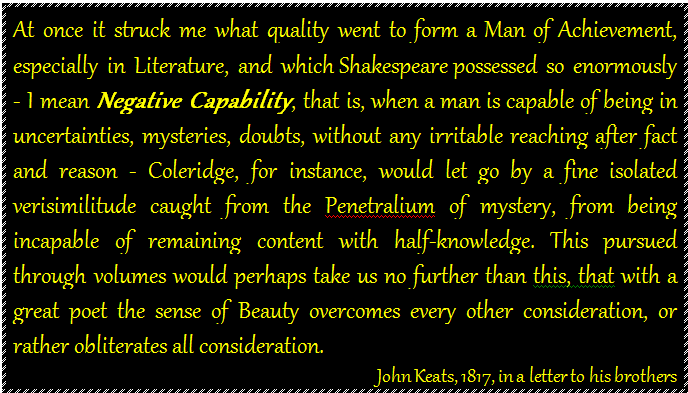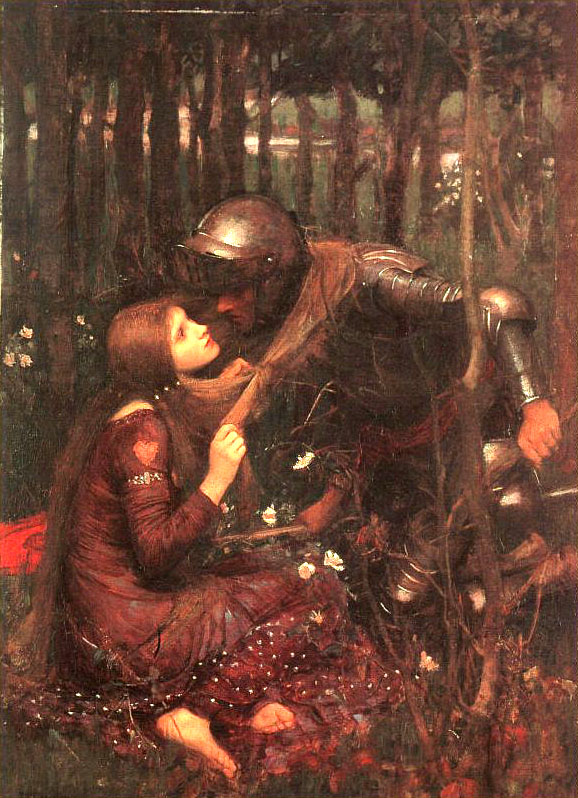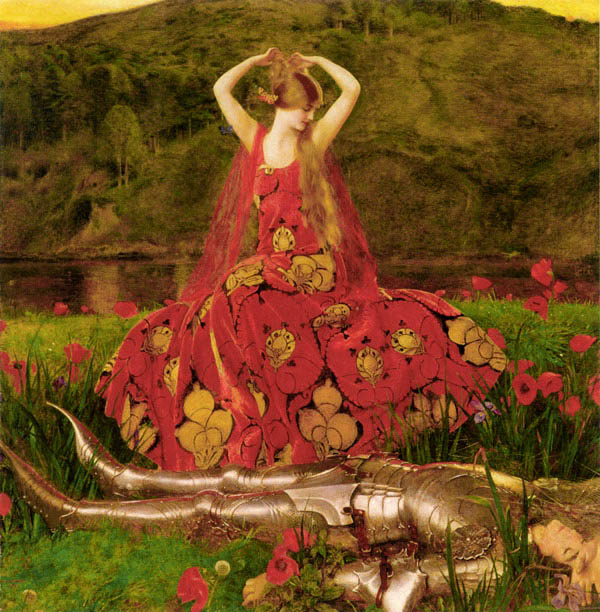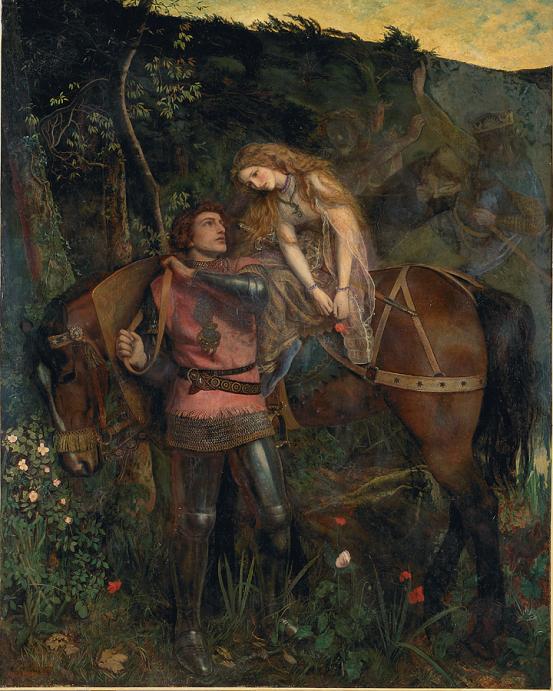Negative Capability: Embracing Uncertainty and Celebrating the Mysterious.
In a letter to his brothers, George and Thomas, found in Letters of John Keats to His Family and Friends and dated December 21, 1817, Keats uses the phrase that has come to be the single most emblematic phrase of his entire surviving correspondence, even though he only makes mention of it once: “Negative Capability” — the willingness to embrace uncertainty, live with mystery, and make peace with ambiguity. Triggered by Keats’s disagreement with English poet and philosopher Coleridge, whose quest for definitive answers over beauty laid the foundations for modern-day reductionism, the concept is a beautiful articulation of a familiar sentiment — that life is about living the questions, that the unknown is what drives science, that the most beautiful experience we can have is the mysterious.
Negative Capability made easy through the appeal of images!
What is this man doing with Keats’s concept? How do you relate to “negative capability”? In other words, do you deem it a useful concept to bear in mind in your life? Why (not)?
Negative capability explained in words!
“The wise man questions the wisdom of others because he questions his own, the foolish man, because it is different from his own.” —Leo Stein, American art collector and critic
In an 1817 letter to a friend, the poet John Keats describes one of the qualities that makes writers like Shakespeare so great: negative capability. Keats defines this trait as “…when a man is capable of being in uncertainties, mysteries, doubts, without any irritable reaching after fact and reason.” In other words, this is the ability to sublimate one’s own individual assumptions about the world and write about uncertain (or potentially polarizing) topics in such a way that the author’s own views remain unknown. It is also the recognition that there are often grey areas in life which cannot be resolved through rational means. This requires an extraordinary degree of objectivity, and it’s much harder than it seems. To enter into the mind of other people (or things) and speak from their point of view is an essential goal for writers.Often some of the most engaging literary works are those where there is no clear side taken on contentious issues (such as the free will versus predestination dichotomy in Shakespeare’s Hamlet or Sophocles’ Oedipus Rex). But the question is, how can writers break free from their own personal perceptions and approach subjects from a more objective point of view?
1. Read writers who are good at negative capability: Keats, Shakespeare, and Sophocles. But there are plenty of other notable authors, such as Emily Dickenson, William Wordsworth, Anne Rice, Walt Whitman, and John Updike.
2. Learn to view situations from other people’s perspectives. Imagine not what you would do if you were facing their circumstances, but rather think about what they would do and why.
3. Step into the unknown. Force yourself to write about subjects or situations you are uncomfortable with (or know little about).
4. Write in a new genre. Tell a familiar tale in a different format. Different literary conventions require different sensibilities, and this can lead to breakthroughs in our perceptions of subjects.
One of the joys of reading is having the opportunity to experience situations from someone else’s perspective. To do this convincingly, writers must learn to put aside their own ideas about the world and imagine alternative possibilities. This is terra incognita for many people, but by embracing this approach, you may discover new avenues of creative potential, and this is exactly what KEATS teachers US! He would have been a great creative writing instructor, wouldn’t he?
La Belle Dame Sans Merci
Different painters were inspired by this poem. Look at their works of art. In the light of the analysis of the poem and your reading of it, which painting do you like best? Why? Try to substantiate your choice with references to the poem itself.
John William Waterhouse
Arthur Hughes
Ode on a Grecian Urn
Look at the following videos to learn more about this great, yet difficult, ode.
The BBC webpage has an interesting section dedicated to The Romantics, worth browsing it: you can see the original manuscript too, if you are interested.
I highly suggest you listen to/watch the following lectures on the ode, so that you expose yoruself to different ways of analysing a poem, to different expressions to explain the same concepts. It is good listening comprehension and a good way to expand your vocabulary and hone your listening skill. Which lecture do you like best? Why? As a student, which teacher/lecturer of these would appeal to you the most? Substantiate your choice. We will discuss this point in class together.
Do you agree that art takes its truth from life and then returns it to life as beauty as is suggested in the poem? The poet seems to suggest that only the dead are immortal how are they immortalized?
This is a detailed analysis that I prepared some time ago for other students of mine. I decided to post it here because some of you may find it useful.
BBC Omnibus, 1995 – To commemorate the bicentenary of sublime English poet John Keats, Andrew Motion (now Poet Laureate) recreates the final, futile voyage from England to Italy
If you go to Rome, do not miss the Keats-Shelley house. It is a great place to visit, especially for people like you, who had the chance to study English literature.









In my opinion the teacher who explaines better the poem is the second one, because he decided to put into his explanation the slides with the text of the poem, so in this way I did not have use the book. Moreover his explanation is useful to understand better the themes of the poem and his meaning. The first one is focused on analyizing the lines of the poem, but he did not explain the meaning of the poem. The third one talked about the poem in a way that is not understandable by a person who does not know the analysis of the poem.
LA BELLE DAME SANS MERCI
The painting I prefer is the first one by John William Waterhouse. In this picture we can see a knight and a beautiful lady, they are in love in fact we can see it in their eyes. The knight is blocked by the lady with her long hair. It seems autumn, in fact the colours are dark, that symbolize the end of the life. The woman is beautiful, she has long brown hair and she wears a red dress. Her eyes are not full of passion, maybe she is thinking about something else. They want to kiss but something fright them or maybe is the choice of the painter to represent the scene before the action. Also the other artists love to represent their masterpieces before or after the action. For example Canova represented his sculptures after the actions, like “Teseo sul Minotauro”. Maybe the knight will fall and die in pain. We cannot understand the real continuarion of the story in the painting. Like Keats, also Waterhouse creates an imaginary world that seems so real to someone in love.
“La Belle Dame sans Merci”
Proposed four paintings I prefer the one by John William Waterhouse. In my opinion it is the most suitable for the ballad of John Keats “La belle dame sans merci.” The picture represent the meeting of the beautiful young girl with a knight. The painter decides to represent the moment when the girl, with her crazy eyes, looking straight into the eyes of the knight is enchanting him. She does him fall in love with her, to have power over him. The girl is kneeling on the grass between the trees and is attracting the guy with the long hair. It almost seems that he is hypnotized. The colors of the painting are soft and warm with a few light spots. On the second floor we see the nature that seems to be involved in the particularly report between young people, it makes no contrast. This picture definitely better corresponds the story told by Keats.
Semenyuk Iryna 5F
Among these three videos, the one I prefer is the second one. The first one is good if you have to do a quick revision of the poem and you want to listen to the main points. Of the third one I like the way the teacher explains how you should approach to the Keats’s work, providing concrete examples, and I think it’s quite evident that he’s talking to high-school students who have never read the ode before. So the reason why I chose the second video is because the speaker adds something else, beyond the, so to say, “scholastic” analysis. For example when he illustrates the meaning of the penultimate line “Beauty is truth, truth beauty”. He says that Beauty and Truth are the same thing for the urn, but not for common people; for human beings time flows away, the beauty changes with it and sooner or later everybody is bound to face his own death. Moreover through art Beauty is enhanced and frozen in that moment, it’s not living. On the contrary humans have to go through pain, love, sufferance, astonishment, in one word LIFE in order to know what really Beauty and love is.
Personally, having viewed the videos, I find that the second one gives the deepest analysis of Keats’s “Ode on a Grecian Urn”.
The first speaker summarizes the poem without giving an interpretation, which is indispensable in my opinion. The third presenter provides examples to simplify the overall comprehension of the poem and also explains the irony that is hidden by Keats’s amusing descriptions.
I firmly believe that the second video clip goes truly through the analysis of the poem and the commentator takes some time to think upon the line “Beauty is Truth, and Truth is Beauty”. For the urn, time is frozen, it is immortal so beauty and truth lie on the same level: they are bound by the same meaning.
To mortals beauty and truth are interchangeble, They are dynamic over time. Keats remarks this state of imperfection of man with irony.
What the third speaker states that the other two don’t, is the antithesis between love (an expression of life) and death (represented by the urn).
I liked both the second and third lecture, because they are much more detailed than the first one and they both try to explain it in the simplest and clearest way, providing us with useful examples and trying to draw a parallel between what Keats said and what we can experience in our everyday life. But, if asked to choose between the two of them, I would probably opt for the second one, since he looked more confident and had a precise idea of what he wanted to say and he went on talking without losing the thread of what he was saying. I think this is fundamental for a teacher, who has to look confident in order to give something to his students and bequeath them his knowledge in an effective way.
The video I like the best is the second, because it is a complete resume and at the same time a detailed explanation of the poem. There are images of urns, some verses of the Ode where are highlightened the important words and last but not least the way this teacher explanes and interpret the masterpiece of Keats is very envolving and above of all clear!
He made me clear the symbol of the urn. It is a beautiful creation of human being and symbolize our death, our end but somehow it makes us eternal by perserving us in time and
conserving our identity for ever!
Out of the three lectures of “Ode on a Grecian Urn” the one I prefer the most is the second one because the lecturer explains the poem in a simple way and with a clear language. I really like the passage in which he talks about one of the most cryptic verse of the poem: “Beauty is truth, truth beauty” wrote Keats and the man in the video clarifies that for the urn beauty and truth are the same thing, while for a living person they are not the same because beauty changes by the time, it is not immortal as art is and the truth is that we have all to move towards death. So, as human beings, we have to deal with sorrow, loss, pain and with suffering in general in order to comprehend what real beauty is. Moreover I appreciate this lecturer because he is the only one who goes beyond the shallow interpretations of the poem, trying to understand and explain the deep meaning of Keats’ words; furthermore I like the fact that he makes links with other poems because it helps to comprehend some aspects of the poem. Finally, I have to say that I like even the third lecturer for some reasons: one of these is that he makes concrete examples to his students in order to make them get the picture and then because he does it by comparing what Keats described to everyday situation, with the result of an immediate understanding of the poem.
ODE ON A GRECIAN URN
The video that I liked the most was the second one, (Romantic poetry #28 Ode on a Grecian Urn). Right from the start the lecturer emphasizes the origin of the Ode, projecting the ideal reader (or listener, in this case) back at the Grecian age, giving us the idea of feeling the same emotions that invaded Keats at the sight of the urn in the museum. As a matter of fact, reading the first stanza of the ode, give us the idea of something antique, fragile and mysterious.
The lecturer, then, proceeds describing the imagines painted on the urn: there is people dancing, having fun, laughing. There is music and wild ecstasy. They are all persuaded by a sense of bliss. I really appreciated the enthusiasm of the speaker while explaining the Ode, because it is evident that he deeply enjoyed the lyric and he deeply understood it, therefore he wants to spread his knowledge in order to make people see what he sees in this Ode.
I do prefer, though, the first video (Ode on a Grecian Ode short lecture) for what concern the scene of the kiss between the two lovers. I found the description of the scene profound, almost sacred and passionate. The lecturer explained well the juxtaposition between beauty and truth linked with the immortality of the two lovers’ love thank to the urn.
Anyway, if I were asked to tell which lecturer would appeal to me the most, I would choose the second one because of his way of explaining difficult concept in an easy manner.
Sara Pavan
I think that the second video is the one that can describe better the entire poem.
The first one is not complete, i think that it is just to understand the superficial part of the work, but to understand it deeply and completely, I prefer the second one.
The speaker seem very professional, in the sense that it is clear that he knows what he is talking about, that he made a fond study on it and most of all that he is really persuaded (and persuading) by the words of the poem. The man is very passionate in his speech, and I think that he really understand what the poet wanted to share with his Ode.
For this reason, I think that in the third video the teacher is not enough passionate (and he did not describe the whole poem) as the man in the second one, and this is why I did not really like it. Finally I like the second video because it was very easy to follow the explanation, since there are both images and text of the ode in it.
I guess, if every teacher proves to love the subject and the lecture that he teaches (like the man in the second video), all students would learn more and more easily.
Among the three explaination I preferred the second one, because for me it is more sutisfying for students like us that need to go beyond the just “scholastic” analysis (like Elisa said). Then I like the fact that he expresses the gratness of Keats through his own words, trying to involve those who are listening to him. I think that engage students is the most difficult thing, because you have to understand what is the way you have to walk to reach their heart by analysing something bigger than you. So I like this “teacher” because he knows how to do it. Then I like how he describes the urn, saying that over it there are all great images. I think he can transmit the love he feels for literature in general. I don’t like the first one because I think is a little bit “confusing” and the third one because is (the right word is) “scholastic”, when we need to go beyond.
For Keats negative capability is the ability of a person to to understand the feelings and the thoughts of an other person. You have to erase your own feelings and opinions from your head and listen and trying to understand your interlocutor. It is important not just in litterature but even in real life as the man in the video explained.
No doubts: I prefer the second lesson. The first one does not involve enough and does not give you a complete explanation of the poem:the teacher concentrates too much on the review of the poem and does not clarify the meaning of it. I found the third one too much scholastic: it’s ok if you are talking to a class, but does not add nothing personal or interesting. Moreover, the teacher focuses his attention on Keats’ life.
The second one is the more complete and well structured: the teacher uses the right speaking level and gives you examples from the text, adding something more than the explanation of the third lesson. I really appreciated that he shows you the stanza where the example is taken from while he is explaining, because is really useful and helps you to imagine the scene.
Finally I decided for it because is the only one which puts attention on the two key-passages of the lyric: the irony of love, that is represented just in one moment, but it is something that lasts for a long time and causes you sufferance; and the concept of beauty: for the urn beauty lasts, but for humans the time flows away and the beauty fades with it.
ODE ON A GRECIAN URN: LECTURES
For me it is very difficult to choose just one of the three lectures, in particular because all the speakers are really experienced, competent and can express the same big passion and enthusiasm for Keats and his work. This author represents their world, their life and they want to share with everybody what they discovered and know about the secrets that “Ode on a Grecian Urn” hides.
Well – if I must be sincere- I find the first explanation too traditional and without any type of “addition” to the classic, bare, “perfect analysis” that we read in literature books. So the lecturer doesn’t say nothing more than what I can grasp from reading the poem by myself. Neither his expressive ways nor what he says can involve me. The Ode remains something stranger and foreign; I read and understand but I do not perceive as mine what is written.
The other two lectures are for many reasons “at the same level” of originality and personality. The second one introduces the element of irony in the ode, an aspect not always immediate to catch, which shows the intensity used by the speaker who tries to entry into the spirit, the soul of this work and tries to reveal Keats’ real figure just like a detective does with his suspected. Unfortunately he makes this “trip” through the Ode alone and the audience is not allowed to follow him: the lecturer has the role of messenger, he is the link between Keats’ verses and the readers. He has the capability to go beyond the direct, literal meaning in the lines and then to communicate what he finds; readers could not be able to do the same. They can just wait his “translation”, but they understand that this lack will always make them inferior to him. He represents the acculturated intellectual who is too far from common people and this aspect can be perceived also in his language, body language and obviously looking at his attire. This is why, even if I admire the second speaker for his great knowledge and charm and I think his lecture could be considered a model lesson to explain Keats’ “Ode on a Grecian Urn” (for example at university), I must admit I prefer the last speech.
Firstly I have been dazzled by the simple, colloquial and welcoming approach that the third speaker has. Secondly it is absolutely brilliant the way in which he tries to transfer the work in our reality and, at the same time, to transfer us into the work through the contextualization of what stands in the lines. From the beginning he creates the right atmosphere where our imagination can burst out and be free, but simultaneously it can be guided by his help (of the lecturer). So I am no longer a simple reader, always separated by an obstacle/wall from the world beneath the words. I become a traveler, that traveler who visits the museum where the urn is located and sees it, who can give testimony of what he sees. I am not a spectator: I see, feel, hear…and live what is illustrated in the urn. I become a character painted in the urn, just like the lovers, the trees, the crowd,…And for a moment the time stops and I am immortal too; the speaker does not exist anymore and I can go on alone. For the first time the audience does not meet a perfect text analyzer or an acculturated intellectual, it meets a common man between men, endowed with a great power of relationship with his students and people in general. Thanks to him and his lecture “Ode on a Grecian Urn” becomes more than a simple work, it becomes a travel in our heart and mind, a travel that will survive for ever.
The quard that I liked the most is the third one. It is very reppresentative of the poem by Keats. The woman seems to be passive and indifferent towards the feelings of the knight. It seems that she uses him for her own interests and pleasure but never thinks about his heart. She is cruel. And the knight sems to be killed by her indifference and by his love that is not reciprocated, so he suffers till death.
I found the first video of “the ode on a grecian urn” very clear in explaining. The man explains in details the structure and the meaning of this poem but I think that he is very detached it seems that he is not emotionally envolved in this poem but just wants to teach to the listener how to make an analysis of this poem. The second video is more envolving due to the slides and images that make you listen the lesson with more attention, the explanation is very clear and detailed. The third video is the one I liked the most there is some kind of comprehension between the listener and the “teacher”, he is very clear and simple in explanation, which is not formal. It seems even that he is envolved in this poem like he is really interested in teaching us something new about it that we do not know by ourselves.
I think that the first one is the best, even if it has some cons. For me the poem’s analysis made through lecture results interesting, for the content, but a little bit heavy for the way it is presented. I love the lecturer too; I really appreciate his tone of voice, which inspires tranquillity, and how he can involve who is listening.
The second video uses the “classic” way to present a theme, so for me it is quite trite. I do not even like the speaker, for example I find him slow in saying things. In conclusion, it is well made, but I cannot find something special.
No doubt, the third video, is the one I appreciate less; in my opinion the teacher is, in some circumstances quite distracting and a little bit repetitive.
Anyway, I must admite that his way of illustrating the urn’s pictures strikes me. Lisa C.
Personally speaking, the second lecture was the best. It was very easy to follow his explanation, even for someone who didn’t read the poem. He described perfectly the urn as if it were right in front of him. He also tried to interpret Keats’s intent to “freeze” the moment when the two lovers are about to kiss. He says many times that imagination and senses are very important in this poem, since the action is still. We should use our imagination to guess how the people represented in the urnwill move. I must say I was very involved in this lesson, contrary to the other two. The first was too short and lacking of details. It could’ve been useful just for a review, but not for a full explanation. In the third, instead, I didn’t find a contact with the speaker. I guess it was a registered school lesson, where the teacher explained the poem to his students. To me, it was meant just for students who had the book under their eyes, because he made several references to it.
The four representation of the “Le Belle Dame sans merci” by John Keats are all interesting and particular, but, for me, the first one is the best. I note the protagonist’s raffiguration, which is impressive, but what really strikes me is the particular intensity of their glance. In fact, if you pay attention, it is immediately evident that the jung man is completely controlled by the girl and cannot look away from she. Her face remind the conception of the angel- woman caracteristic of the medieval period; so she really seems to be an innocent and sweet lover.
The second one is perfect to immortalize the very moment when the warrior is subjugate to the will of she. I find the collocation of the two really perfect to idealize the superiorityof the woman and the inferiority of the man. He is defenceless and cannot rebel anymore. than the lanscape is so beautiful that seems to be real.
I do not like the third picture, because it represents a “passive moment”; the man is not conscious and the attention is centred on the cruel lady.
the final one is beautiful, but it looks imaginative. I think this image makes a mixture of fantastic and real elements. I really love the interest of the detail; for example the variety of th flowers painted. Lisa C.
Through the videos posted on the blog, the lectures I like the most are the second and the third ones.
The man, explaining the Ode in the second video, has a calm and peaceful tone of voice, and gave simple and clear explanation. “Keats, standing there, can hear the music across the centuries” in my opinion is a very powerful sentence because it conveys the idea of the passing of time, the importance of the works of art, which frozen a moment of common people forever: the urn will remain when we ourselves are gone. I really appreciated his way of explaining the Ode, and I think it would be very useful for a student to watch this video, as it was for me.
I even liked the way the third video was composed, because while the man was talking, images and verses of the poem were sliding one after the other making the viewer better understand what the man was talking about, avoiding to lose the thread.
The video I preferred was the second one, because the speaker was very clear and he analyzed very well the poem. He made me understand very well the irony hided behind the words and made me think about the themes that the poet rises. I have found the parts with the text of the ode useful, because it helps you to concentrate and understand what he means. Even the images were interesting since he made me think about what had probably thought Keats when he decided to write the ode to the urn.
The first video is too short and difficult to follow, because he refers to some parts of the poem that he learned by heart.
The third one is interesting because it is a real lesson so the teacher tries to involve his students but it was a little bit boring to me since I have studied it before. He analyses everything trying to make his students understand the poem and to remember it and I think it could be useful if I have not heard of it before, especially for the introduction.